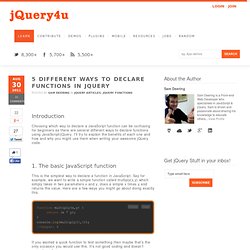

50 Fundamental jQuery Controls, Components and Plugins. Every seasoned developer has one and every young and upcoming developer should be thinking of building one – a good and concise collection of UI controls, components and plugins that you can always rely on in times of need.

Of course, there are plenty of great UI frameworks, kits and libraries that you could use, but none will offer you every component and none of them will be tailored to your own personal preferences and needs. Up until a few months ago my controls had been collected and sourced from various frameworks (Prototype, MooTools, jQuery…), upon review it seemed a little out-dated, some components unnecessary and some controls desperately needed updated.
It seemed logical to give the collection a fresh outlook and a uniformity under one framework – I chose jQuery. (I have held on to a few controls that have not been built with jQuery, but for the sake of this post I have omitted them). So, here are my 50 Fundamental jQuery Controls and Rich UI Components… What would you add? 5 Different Ways to Declare Functions in jQuery. Introduction Choosing which way to declare a JavaScript function can be confusing for beginners as there are several different ways to declare functions using JavaScript/jQuery.

I’ll try to explain the benefits of each one and how and why you might use them when writing your awesome jQuery code. 1. The basic JavaScript function This is the simplest way to declare a function in JavaScript. Function multiply(x,y) { return (x * y);} console.log(multiply(2,2));//output: 4 If you wanted a quick function to test something then maybe that’s the only occasion you would use this. 2. If you need a private utility for getting/setting/deleting model values then you can declare a function as a variable like this. Var multiply =function(x,y){return(x * y);} console.log(multiply(2,2));//output: 4 //The same function but with a self execution to set the value of the variable:var multiply = function(x,y) { return (x * y);}(2,2); console.log(multiply);//output: 4 3. 4. 50 jQuery Function Demos for Aspiring Web Developers - Smashing Coding.
Every aspiring Web developer should know about the power of JavaScript and how it can be used to enhance the ways in which people see and interact with Web pages.

Fortunately, to help us be more productive, we can use the power of JavaScript libraries, and in this article we will take a good look at jQuery in action. What Is jQuery? Link In a nutshell, jQuery is a leading JavaScript library that can perform wonders on your Web pages and make your Web development life much easier and more enjoyable. With the rise in popularity of jQuery since its arrival in 2006, over an estimated 24 million websites (50% of them being the 10,000 most visited websites) currently reap the benefits, and as Google Trends suggests, it’s the most popular JavaScript library. Thousands of Web developers worldwide use jQuery to innovate on their websites and stay up to date on trends. jQuery And CSS Link Styles play a big part in the look and feel of any website, and jQuery can help us change them dynamically. Instant Documentation Search.